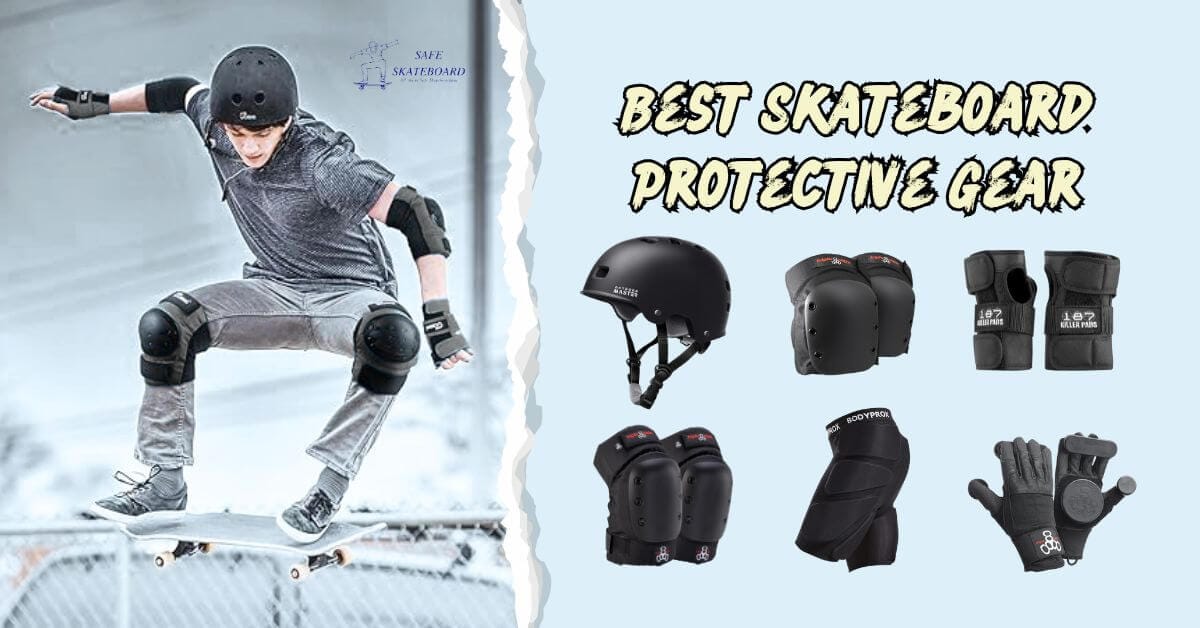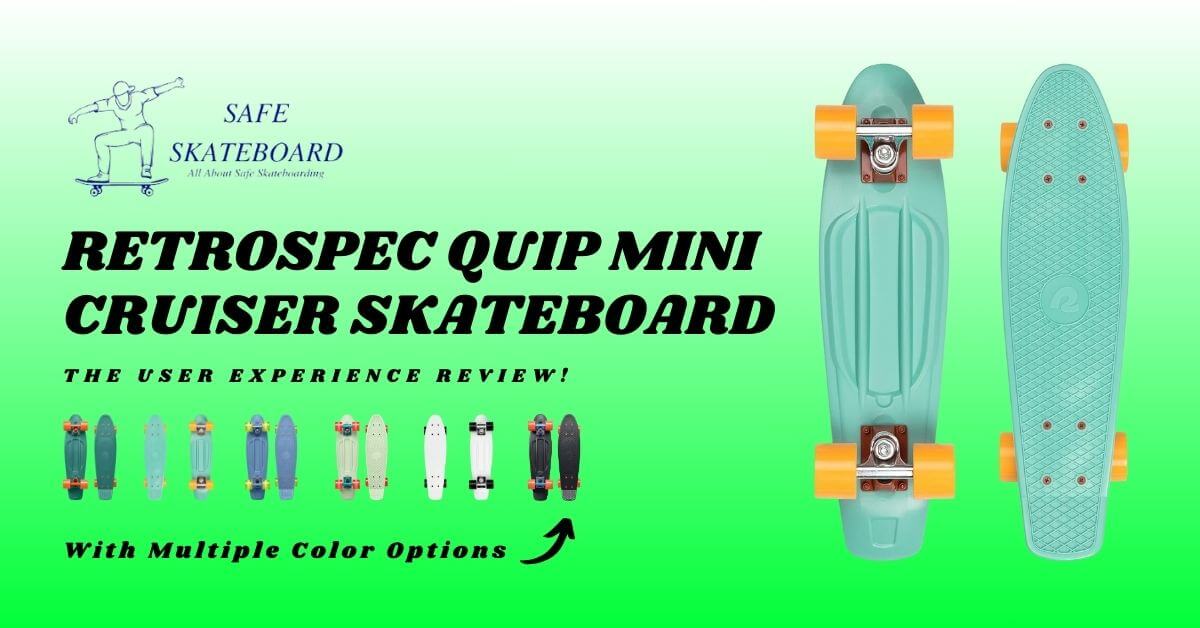To install trucks on a skateboard, align the mounting holes with the holes on the skateboard deck, then secure them in place using the provided hardware. If you want to customize your skateboard or replace old trucks, installing new trucks is a simple process that can significantly impact your skating experience.
Choose the right trucks and correctly install them. So you can enhance your board’s stability, turning capabilities, and overall performance.
In this guide, I will walk you through the step-by-step installation of trucks on a skateboard. Whether you’re a beginner or an experienced skater, my article will help you get your trucks up and ready to ride in no time. Let’s dive in!
Understanding The Anatomy Of Skateboard Trucks
Install trucks on a skateboard involves understanding the anatomy of skateboard trucks. Familiarize yourself with the different components and their functions to ensure a proper installation.
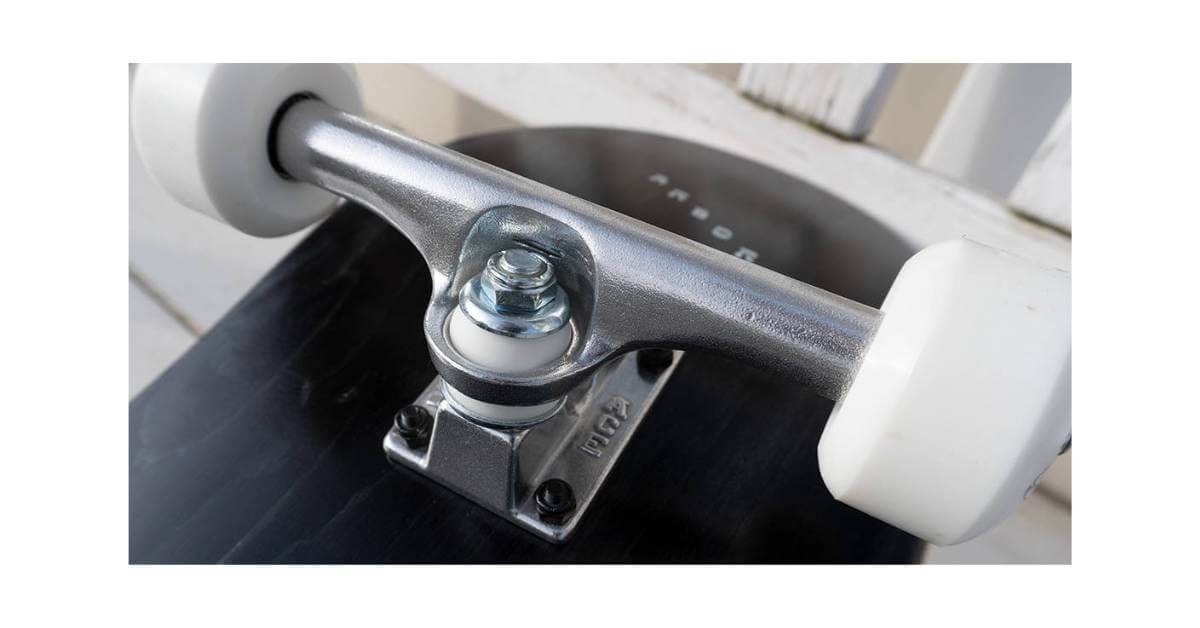
Skateboard trucks are essential to a skateboard’s setup, determining its stability, maneuverability, and overall riding experience.
Whether you’re a beginner or a seasoned skater, it’s crucial to understand the various components that make up skateboard trucks.
In this section, I will delve into the anatomy of skateboard trucks, discussing the components and emphasizing the importance of proper truck installation.
Components Of Skateboard Trucks
Skateboard trucks consist of several key components, each playing a vital role in the performance and functionality of the trucks. So, here are the main components you should be familiar with:
- Hanger: The hanger is the largest part of the skateboard truck and provides the axle that connects the wheels to the deck. It is typically made of metal and directly affects the stability of the skateboard.
- Axle: The axle is a long rod that runs through the hanger and holds the wheels in place. The length of the axle determines the width of the skateboard, and it is essential to choose an axle length that matches the width of your deck.
- Kingpin: The kingpin is a large bolt that runs through the hanger and holds the various components of the skateboard truck together. It also allows for adjustments to the tightness of the truck, affecting how easily it turns.
- Bushings: Bushings are cylindrical cushions made of urethane that sit between the hanger and the baseplate. They provide the cushioning and steering response of the skateboard by allowing it to turn smoothly. Softer bushings allow for looser turns, while harder ones provide a more stable and rigid ride.
- Baseplate: The baseplate is the flat metal piece that attaches the truck to the skateboard deck. It is usually mounted to the deck using multiple screws and acts as the foundation for the entire truck assembly.
Importance Of Proper Install Trucks on a Skateboard
Ensuring proper truck installation is crucial for optimal skateboard performance and rider safety. Here’s why proper truck installation matters:
- Stability: Correctly installed trucks provide a stable platform for riding, allowing skaters to maintain control and balance on their boards. Proper alignment and tightness of the components contribute to stability while performing tricks or cruising.
- Maneuverability: By installing trucks correctly, skaters can fine-tune the turning and responsiveness of their boards. Adjusting the tightness of the kingpin and choosing the right bushings allows for a customized ride suited to individual preferences and styles.
- Safety: Improperly installed trucks can lead to accidents and injuries. Loose or misaligned components can cause wheel wobbles, compromising stability and making it harder to control the skateboard. It is essential to ensure all parts are securely tightened and correctly aligned.
- Durability: Proper installation contributes to the longevity of skateboard trucks. Loose or incorrectly installed trucks can result in excessive wear and tear on components, leading to premature damage or breakage.
To fully harness the potential of your skateboard and enhance your skating experience, taking the time to understand the anatomy of skateboard trucks and installing them correctly is essential.
It ensures optimal performance and keeps you safe while hitting the streets or tearing up the skatepark.
Essential Tools For Install Trucks on a Skateboard
Discover the essential tools for installing skateboard trucks, ensuring a smooth ride. These tools, from wrenches to screwdrivers, are necessary for secure and effective truck installation.
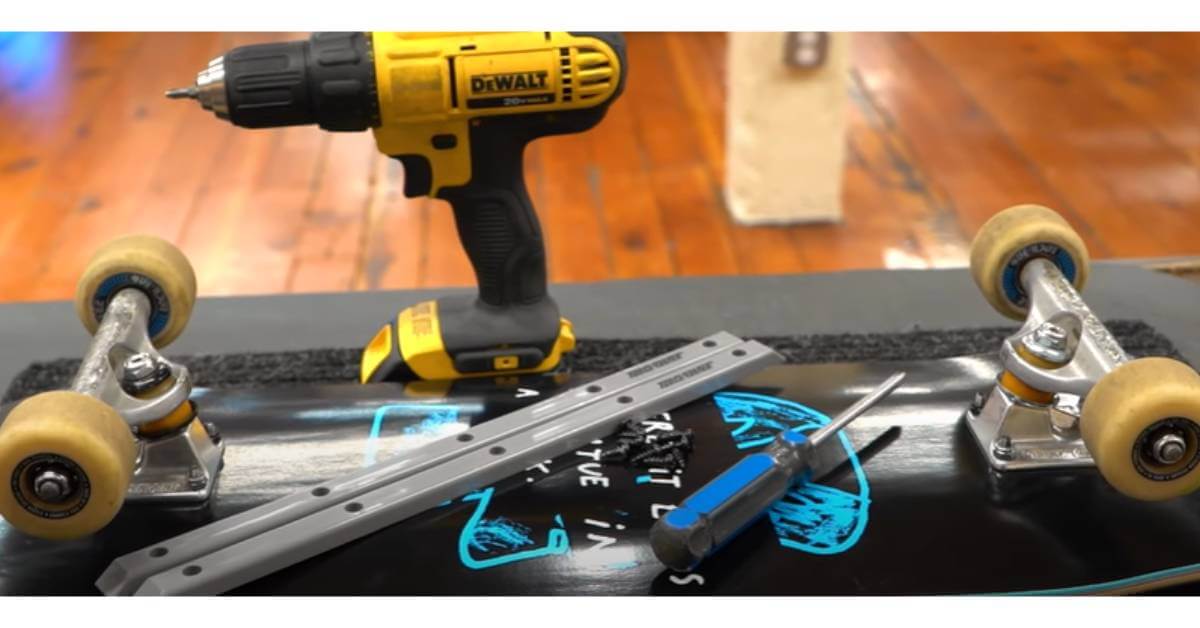
Installing trucks on a skateboard is essential in customizing your ride and improving your skating experience. To ensure a successful installation, you will need a few essential tools.
In this section, I will explore the indispensable tools required for installing skateboard trucks and recommend some trusted brands and types.
List Of Tools Required For Installation
In this section, I’ll show you why these tools are essential. They make installing your trucks easier, ensuring a secure fit for a smoother ride.
- Skateboard tool: This versatile tool is a must-have for any skateboarder. It typically features a 3/8″ socket for mounting hardware, a 1/2″ socket for axle nuts, and a 9/16″ socket for kingpin nuts. With a skate tool, you’ll have everything you need to loosen or tighten various skateboard components.
- Ratchet or socket set: While a skate tool covers most needs, having a ratchet or socket set can provide extra leverage and precision when necessary. These tools allow you to apply more force to tighten or loosen stubborn bolts and nuts effectively.
- Screwdriver: A Phillips head or Allen essential screwdriver is needed to attach the truck baseplates to the skateboard deck. Make sure to have the appropriate size for your specific truck hardware.
- Razor blade or box cutter: A sharp blade helps remove grip tape or excess stickers from your skateboard deck. It can also help fine-tune the grip tape around the truck holes, ensuring a clean installation.
So, you’ll be ready to hit the streets or skatepark with a customized board that meets your riding style and preferences.
How to Install Trucks on a Skateboard: Step-By-Step Guide
Learn how to install trucks on a skateboard with this step-by-step guide. From choosing the right tools to adjusting the tightness, we’ll show you how to attach your trucks securely for optimal skateboarding performance.
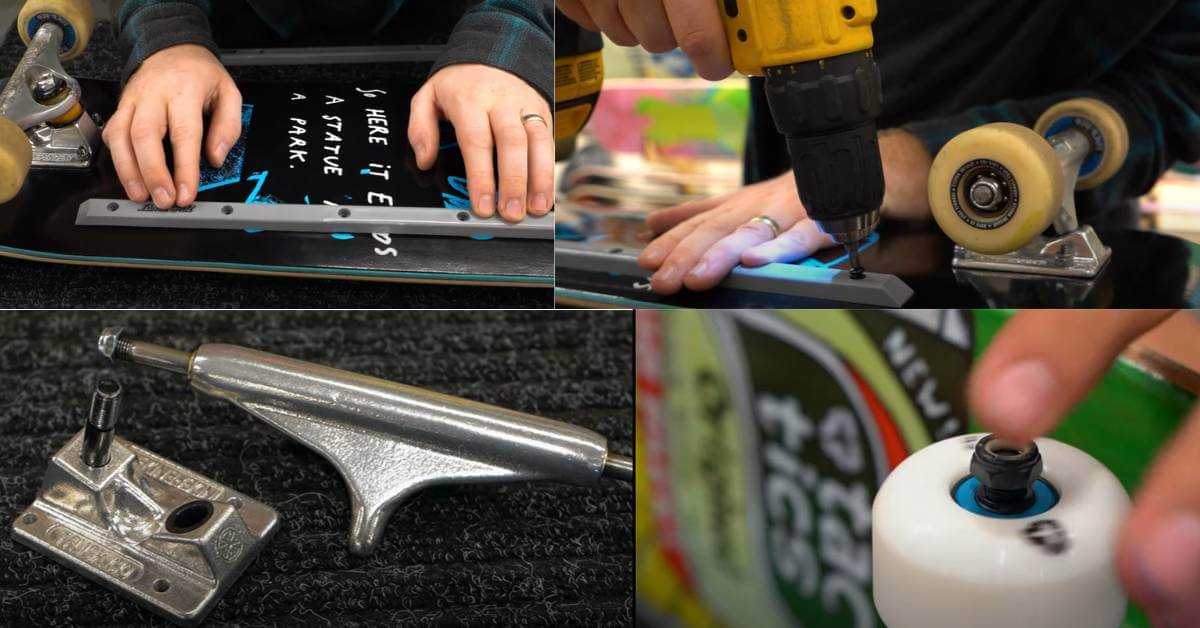
Step 01: Preparation And Safety Precautions
Before installing trucks on your skateboard, it is essential to take some necessary preparatory steps and follow safety precautions to ensure a successful and safe installation. Here’s what you need to do:
- Gather your tools: To start, gather the necessary tools, including a skate tool, a wrench, and a screwdriver. These tools will come in handy during the installation process.
- Choose the right trucks: Selecting the appropriate trucks for your skateboard is crucial. Consider your skateboarding style, weight, and personal preference when choosing the trucks that best suit your needs.
- Find a suitable workspace: Find a stable and spacious installation area. Ensure the surface is clean and flat to prevent accidents or damage to your skateboard.
- Wear protective gear: It is always important to prioritize your safety. Put on protective gear such as a helmet, knee pads, and elbow pads to minimize the risk of injuries while working on your skateboard.
Step 02: Removing The Old Trucks for Install Trucks on a Skateboard
Now that you have taken the necessary precautions, it’s time to remove the old trucks from your skateboard. Follow these steps:
- Loosen the hardware: Use your skate tool to loosen the trucks‘ bolts. Ensure they are loose enough to remove the trucks from the skateboard deck easily.
- Remove the old trucks: Carefully remove the old trucks from the skateboard deck once the bolts are loosened. Also, set them aside, as you will no longer need them.
- Clean the skateboard deck: Take this opportunity to clean the skateboard deck by removing any dirt, debris, or old grip tape residue. Thus, it will ensure a clean surface for mounting your new trucks.
Step 03: Adjusting The Bushings For Optimal Performance
Bushings play a significant role in the performance and maneuverability of your skateboard. So, follow these steps to adjust the bushings for optimal performance:
- Determine your riding style: Consider your preferred style of skateboarding, whether street, vert, or cruising, and adjust the bushings accordingly.
- Choose the suitable durometer: Bushings come in different durometers, which affect their hardness. The softer the bushings, the more responsive they will be. Experiment with different durometers to find the perfect fit for you.
- Adjust the tightness: Loosen or tighten the kingpin nut to adjust the tightness of the bushings. Also, experiment with different levels of tightness until you find the right balance between stability and maneuverability.
Step 04: Mounting The New Trucks On The Skateboard Deck
With the old trucks removed and the bushings adjusted, it’s time to mount the new trucks onto your skateboard deck. Here’s how:
- Line up the holes: Place the trucks on the skateboard deck, aligning the holes on the baseplate with the holes on the deck. Make sure they are centered and parallel to the skateboard’s length.
- Insert the bolts: Insert the screws into the holes, ensuring they pass through both the baseplate and the skateboard deck. Start with one bolt per truck to hold them in place before inserting the rest.
- Hand-tighten the bolts: Use your fingers to hand-tighten the bolts until they are secure. This will ensure proper alignment before using the tools to tighten them fully.
Step 05: Tightening The Hardware Properly
To complete the installation, it is crucial to tighten the hardware correctly. Follow these steps:
- Use a skate tool: Grab your skate tool and tighten each bolt in a diagonal pattern. Start with one bolt and move to the bolt diagonally opposite it. Continue this process until all bolts are tightened evenly.
- Avoid overtightening: Be careful not to overtighten the bolts, as this can damage the skateboard deck or restrict the trucks’ movement. Tighten them just enough to ensure a secure fit.
Congratulations! You have successfully installed new trucks on your skateboard.
Now, it’s time to hit the streets or skatepark and enjoy your skateboard’s improved performance and maneuverability. Also, remember always to prioritize your safety and have fun while skateboarding!
Raleted Article: How to Clean Skateboard Trucks!
Common Mistakes To Avoid When Install Trucks on a Skateboard
When installing trucks on a skateboard, avoiding common mistakes affecting overall performance is essential.
Thus, you can ensure a smooth and stable ride by following the proper techniques and avoiding errors such as improper alignment or using incorrect hardware.
Skateboarding is an exhilarating and popular sport that requires proper equipment installation and maintenance. When installing trucks on your skateboard, it’s essential to avoid common mistakes that could affect your overall riding experience and safety.
In this section, I’ll discuss three critical mistakes to avoid when installing trucks: over-tightening or under-tightening the hardware, incorrectly placing the trucks on the deck, and ignoring proper bushing adjustment.
01. Over-Tightening Or Under-Tightening The Hardware
Tightening the hardware too much can lead to stress cracks on your deck, making it prone to breaking.
On the other hand, under-tightening the hardware can result in loose and unstable trucks, affecting your balance and control while riding.
The ideal balance is to tighten the hardware until it’s snug but not so much that it compresses the deck. This allows for optimum stability and maneuverability.
02. Incorrect Placement Of The Trucks On The Deck
Placing the trucks too close to the edges of the deck can cause wheel bite, where the wheels come into contact with the deck during turns, leading to falls or difficulty maneuvering.
Conversely, positioning the trucks too close to the center of the deck can affect your stability and make it challenging to perform tricks.
The recommended position is to align the trucks with the width of the deck, allowing enough room for wheel clearance while maintaining balance and control.
03. Ignoring Proper Bushing Adjustment
Bushings are the rubbery components of the trucks that provide cushioning and control while riding.
Neglecting to adjust the bushings according to your weight and riding style can result in either too stiff or too loose trucks.
Adjusting the bushings allows for a customized riding experience, offering optimal stability and responsiveness. Finding the right balance based on your preferences and riding style is essential.
Regular maintenance is also crucial to ensure the longevity and performance of your trucks. This includes regularly checking for loose hardware, monitoring the condition of the bushings, and periodically cleaning and lubricating the bearings.
Troubleshooting Tips For Truck Installation Issues
Have trouble with installing trucks on your skateboard? Check out these troubleshooting tips to help you overcome common installation issues and get your trucks securely in place.
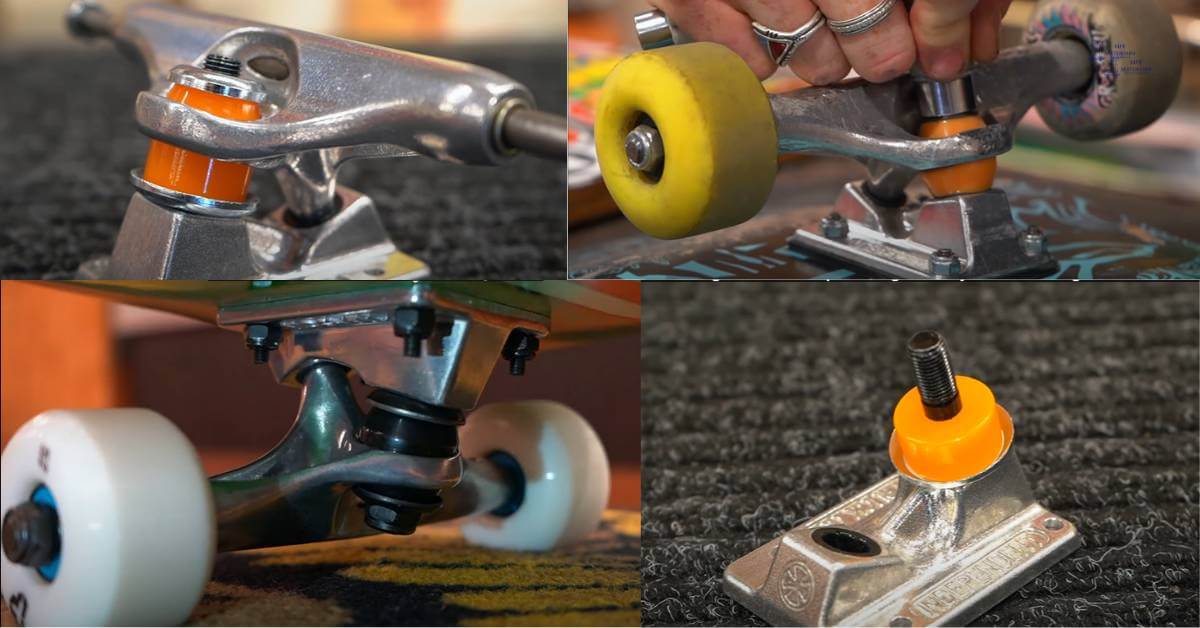
01. Uneven truck height
- Check if the kingpin is tightened equally to ensure even truck height.
- Adjust the bushings on each side to balance the truck height.
- Ensure the pivot cup is installed correctly and does not cause any height discrepancies.
02. Wheel bite problems:
- Use riser pads to increase the distance between the wheels and the skateboard deck, minimizing the chances of wheel bite.
- Tighten the trucks slightly to reduce the amount of wheel movement and prevent wheel bite.
- Consider using softer or smaller wheels that are less prone to causing wheel bite.
03. Loose or wobbly trucks:
- Ensure the truck bolts are securely tightened, but avoid overtightening as it may hinder maneuverability.
- Check the bushings and replace them if they are worn out or deformed.
- Adjust the tightness of the kingpin to find the optimal balance between stability and responsiveness.
Regularly inspect your skateboard for any signs of wear and tear and make necessary adjustments or replacements to maintain optimal performance.
Troubleshooting these common truck installation issues can ensure a smoother and more enjoyable ride. Happy skating!
Raleted Article: How to Replace Skateboard Trucks!
Enhancing Performance With Truck Customization
Enhance your performance on a skateboard with truck customization. Discover how to install trucks on your skateboard for optimal control and maneuverability. Experience improved riding and take your skills to the next level.
A skateboard is more than just a deck with wheels – its performance can be significantly enhanced by customizing its trucks. The right choice of trucks, angles, configurations, and additional accessories can dramatically impact your skateboarding experience.
In this section, I will explore how to enhance your skateboard’s overall performance through truck customization.
Choosing The Right Type Of Trucks For Your Riding Style
Picking the right trucks is key to matching your riding style. The right choice enhances control, balance, and overall performance, making every ride smoother and more enjoyable. Let’s see what are the best skateboard trucks:
- Standard trucks: Ideal for all-around skateboarding, providing stability and versatility for various riding styles.
- Low trucks: Great for street skateboarding, offering increased stability during technical tricks.
- High trucks: Perfect for vertical skateboarding or cruising, providing more clearance for larger wheels.
- Wide trucks: Suitable for larger riders or those seeking more stability during high-speed rides.
- Narrow trucks: Preferred by technical street skaters for improved maneuverability and quick turns.
Exploring Different Truck Angles And Configurations
Understanding truck angles helps you fine-tune your skateboard’s performance. Whether you want sharper turns or more stability, adjusting the angle can make a noticeable difference in your ride.
- Standard angle (50-54 degrees): Offers a balanced and versatile ride for most skaters.
- High angle (55-60 degrees): Enhances turning and responsiveness, ideal for carving or downhill riding.
- Low angle (less than 50 degrees): Provides stability and is commonly used by longboarders or cruiser riders.
Adding Riser Pads For Increased Height Or Stability
Slanted riser pads can adjust the truck angle and tailor it to specific riding styles. Flat riser pads Increase the skateboard’s height, offering more clearance, reducing the risk of wheel bite, and improving stability.
Customizing your skateboard’s trucks not only allows you to fine-tune its performance but also enables you to optimize it for your specific riding style.
With the right combination of trucks, angles, configurations, and additional accessories like riser pads, you can take your skateboarding to a new level.
Maintaining And Caring For Skateboard Trucks
A critical aspect of maintaining and caring for skateboard trucks is knowing how to properly install them on a skateboard.
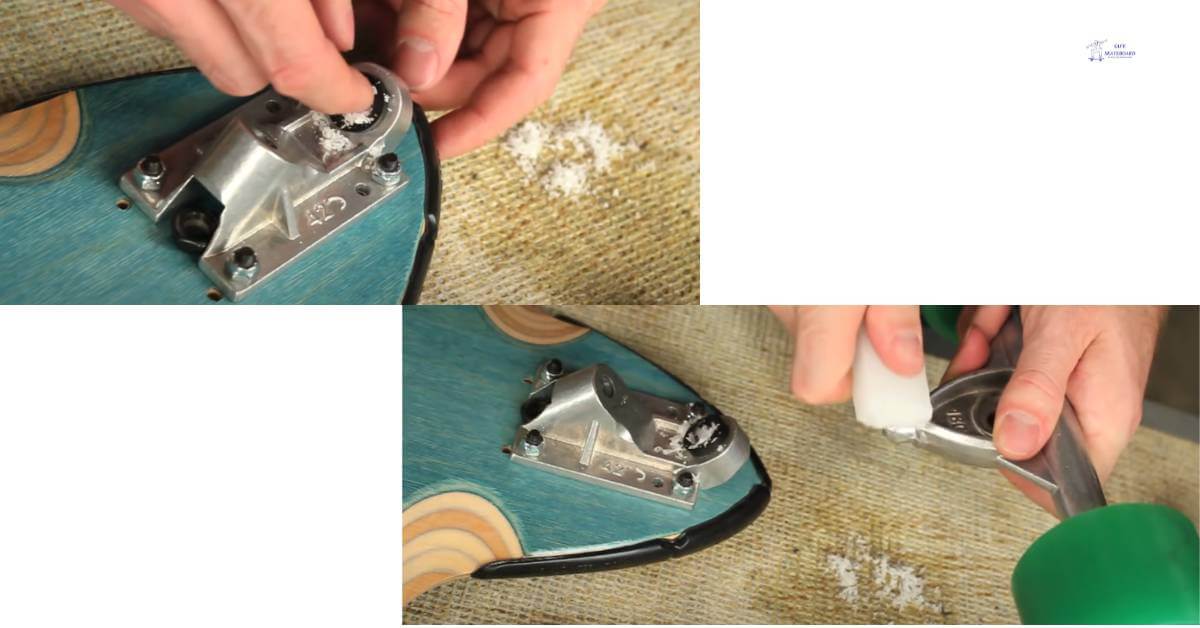
Following the correct steps and using the right equipment ensures your trucks are securely attached and ready for skateboarding adventures.
Skateboard trucks are essential for riders to turn, maneuver, and perform tricks on their boards.
While installing trucks on a skateboard is crucial, maintaining and caring for them is equally essential to ensure optimal performance and longevity.
This section will explore some essential practices to keep your skateboard trucks in shape.
Cleaning And Lubricating The Trucks Regularly
- Use a dry cloth or brush to remove dirt, debris, and grime from the trucks.
- Apply a skateboard-specific cleaner to clean the trucks effectively.
- Once the trucks are clean, lubricate the pivot cup and bushings with skateboard-specific lubricant.
- Regularly cleaning and lubricating the trucks will help minimize friction, prevent rust, and improve overall performance.
Checking For Signs Of Wear And Tear
- Regularly inspect the skateboard trucks for any visible signs of wear, such as cracked or bent hangers, worn bushings, or loose hardware.
- Look for uneven wear on the pivot cup, which is affecting steering and stability.
- Check the kingpin for any signs of bending or damage.
- Pay attention to any unusual sounds or vibrations during rides, which may indicate truck issues.
Replacing Worn-Out Or Damaged Components
- If you notice any significant wear or damage on the trucks, it is crucial to replace the affected components promptly.
- Replace worn-out or compressed bushings to maintain stability and responsiveness.
- Damaged or bent hangers should be replaced to ensure proper alignment and functionality.
- Keep an eye on the pivot cup and replace it if it becomes excessively worn or damaged.
- Regularly inspect and tighten all hardware to prevent any loose or unstable parts.
By following these maintenance practices, you can ensure that your skateboard trucks remain in optimal condition for extended periods, allowing you to enjoy a smoother and safer riding experience.
Remember to clean and lubricate the trucks regularly, check for signs of wear and tear, and promptly replace any worn-out or damaged components.
With proper care, You will perform the most impressive skateboard tricks and cruise with style.
Expert Recommendations For Skateboard Truck Installation
Looking to install skateboard trucks? Get expert recommendations for a seamless installation process. Follow these step-by-step instructions for an easy and hassle-free setup.
Skateboarding is not just about riding a board; it’s also an art form, a lifestyle, and a sport that requires skill and expertise.
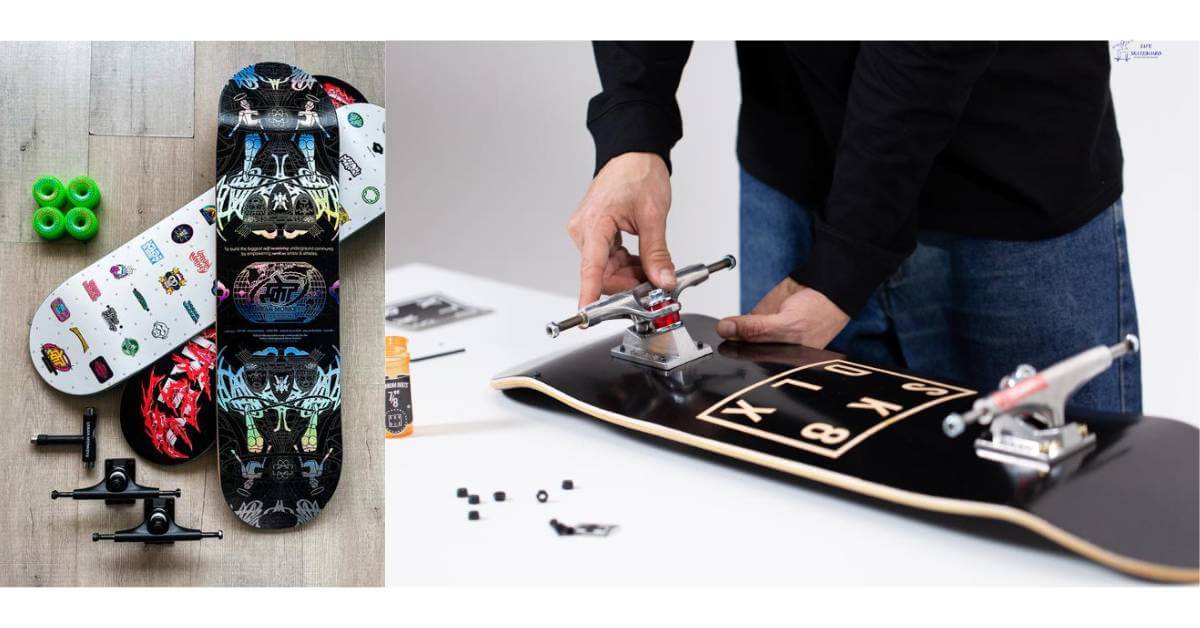
When installing trucks on a skateboard, there are various techniques and recommendations from professional skateboarders and industry experts to ensure optimal performance and stability.
So, I will explore these expert recommendations, discuss standard techniques experienced riders use, and delve into the debate between personal preference and industry standards.
Tips From Professional Skateboarders And Industry Experts
- Ensure you have the necessary tools, including a skate, wrench, and screwdriver.
- Start by placing the skateboard deck on a flat surface, with the nose facing upwards.
- Remove the kingpin nut from the truck, allowing it to rest on the baseplate.
- Align the truck holes with the corresponding holes on the skateboard deck.
- Insert the truck bolts through the holes, securing them tightly without overtightening.
- Use a skate tool or wrench to tighten the nuts until they are snug, ensuring the trucks are evenly placed.
- Test the skateboard for stability and adjust the tightness of the nuts if necessary.
Standard Techniques Used By Experienced Riders
- Risers: Some skateboarders prefer using riser pads between the truck and the deck to increase the distance and avoid wheel bite. This technique is particularly helpful for riders who enjoy performing tricks and riding ramps.
- Angled Hardware: Using angled hardware, skateboarders can alter the angle of the truck, providing a customized feel and performance. Riders who prefer a specific turning radius or board response often utilize this technique.
Personal Preference Versus Industry Standards:
- While personal preference plays a significant role in skateboard truck installation, it’s essential to consider industry standards for optimal performance and safety.
- Industry standards usually suggest placing the front truck towards the nose of the skateboard and the back truck towards the tail. This positioning provides stability and balance.
- However, some skateboarders may prefer experimenting with different truck positions, such as a more centered setup for better maneuverability or a wider stance for stability during high-speed rides.
- Finding the perfect truck installation is subjective, and it often takes time and experimentation to discover the setup that suits your riding style and preferences.
Install trucks on a skateboard requires attention to detail and a thorough understanding of its impact on your overall skating experience.
Whether you follow the tips of professional skateboarders, experiment with different techniques, or balance personal preference with industry standards, the key is to create a setup that allows you to push your limits and enjoy the thrill of skateboarding to the fullest.
Frequently Asked Questions (FAQs) of How To Install Trucks on a Skateboard
How Do I Put Trucks On My Skateboard?
To put trucks on your skateboard, follow these steps: 1. Flip your skateboard upside down. 2. Position the truck holes over the holes in the skateboard. 3. Insert the mounting bolts into the holes and tighten them securely. 4. Repeat the process for the other truck, ensuring they are aligned and tightened evenly.
How Do You Screw A Skateboard Truck?
To screw a skateboard truck, insert the screw into the truck’s hole and use a screwdriver to tighten it securely.
Where Do The Trucks Go On A Skateboard?
Trucks on a skateboard go underneath the deck and are attached to the wheels.
Can You Install Any Trucks On Any Skateboard?
No, you cannot put any trucks on any skateboard. The trucks must be compatible with the skateboard.
Executive Summary
Do you understand how to install trucks on a skateboard? To sum it up, installing trucks on a skateboard is an essential skill for skateboarders of all levels, whether you are a beginner or an experienced rider.
Following the step-by-step process outlined in this guide, you can easily attach the trucks to your skateboard and ensure a safe and smooth ride.
Remember to select the right truck size that matches your deck, tighten the hardware correctly, and regularly check for loose bolts or signs of wear and tear.
Additionally, experimenting with different truck setups can help you customize your skateboard to suit your style and preferences.
Mastering installing trucks on a skateboard opens up possibilities for enhancing your skateboarding experience and becoming proficient in various tricks and maneuvers.
So, grab your tools, get started, and explore the boundless potential a well-equipped skateboard can offer.














